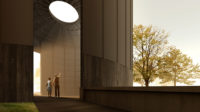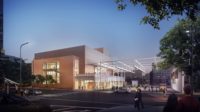Gehry's Serpentine Pavilion Design Unveiled


Images © Frank Gehry Partners LLP
Frank Gehry’s design for the summertime pavilion at London’s Serpentine Gallery, unveiled last week (top). One critic has likened it to an “exploded timber yard” (above).
The Serpentine’s brief requests a fully accessible, weatherproof space in Kensington Gardens, to accommodate as many as 250,000 visitors during the three months of its installation. Gehry responded with a design, unveiled last week, that seeks to create “an urban street connecting the park and the existing Gallery.” His highly articulated timber structure bristles with energy and life in a way that is likely to reflect the bustling range of activities planned for it. To shelter the interior, glass panels will be hung off the pavilion at swooping angles with a sense of drama typical of Gehry’s larger scale public buildings.
Britain’s press is intrigued by the dynamic design, with one newspaper critic likening it to an “exploded timber yard” rather than a conventional public amenity. Gehry has said that he regards his pavilion “much like an amphitheater.” Visitors will be able to sit on terraces flanking the promenade. There will also be five elevated seating pods that people can access via the pavilion’s exterior. These serve as visual markers enclosing the amphitheater, and will provide space for performance stages, private viewing platforms, and dining.
The Serpentine allows a maximum of just six months from invitation to project completion. Only practitioners who have not yet built in England at the time of the invitation from the gallery are eligible. (Gehry’s Maggie Center, in Dundee, Scotland, opened in 2003.) Past architects in the program’s nine-year history include Kjetil Thorsen; Oscar Niemeyer; Toyo Ito, Daniel Libeskind, and Zaha Hadid. Most years, Arup provides engineering and specialist design expertise.



